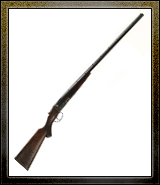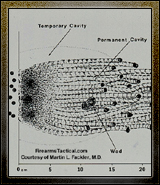 |

Introduction
The double-barreled shotgun is one of the oldest styles of shotgun in existence. It has the fewest moving parts of any shotgun (the mechanism for opening and loading the gun, and the hammers for the firing pins). There are two types of double-barreled shotguns; the side-by-side (SxS) or the over/under (O/U). These names refer to the arrangement of the barrel. The original double-barreled shotguns were SxS. This was because shotguns were originally muzzle loaders; meaning, the charge and projectile were loaded into the weapon via the muzzle or front of the barrel, and the hammers had to be exposed in order to cock the guns so that they could be fired. When hammerless weapons became more practical and common, the O/U design became more popular. Most modern double-barreled shotguns use an O/U design.
Functionality [9/10]
|
 |
|
A generic SxS double-barrel
shotgun
|
Double-barreled shotguns are easy to care for. With fewer parts, breakdown, cleaning, and reassembly are generally quick and easy. Because a standard double-barrel shotgun is breach loading, it is on average at least 4 inches shorter than a repeating or pump-action shotgun with the same length barrel. This translates to a quicker "swing" (the time it takes to turn with the gun on your shoulder). With a double-barreled shotgun, you have two barrels allowing the advantage of being able to fire even if one barrel fails (you have two barrels so you can immediately switch and still be able to squeeze off that crucial shot). Double-barrel shotguns have two different trigger configurations; the first has two separate triggers, one for each barrel. This allows both barrels to be fired at the same time or independently. The other trigger configuration is a single trigger, which will alternate back and forth between the two barrels. This type of trigger is called a single selective trigger (SST). Double-barreled shotguns not only let you fire even if one barrel has failed, but also allow you to take your second shot immediately after the first. All pump action and semi-automatic guns require that the second round be loaded into the chamber before firing while the double is always ready to take that second shot. Unfortunately, you're empty after that second shot, and this weapon will need constant reloading, and can quickly leave you out of ammo at a critical time. It is suggested that reloading this weapon be practiced extensively to decrease load time. Considering that in a post-apocalyptic world it may be easier to repack your own shells than continuously looking for pre made ammo, spent shells from a double-barreled shotgun can be easily removed and pocketed instead of chasing down flying ejected shells from a repeating shotgun.
Effectiveness [7/10]
The double-barrel shotgun has a nice solid frame so the butt of the rife can be used as a club quite well. If you run out of ammo, simply turn your gun around and you have an effective melee weapon. Double-barreled shotguns tend to be very long when equipped with a full length barrel. The down side to using a full barrel is that the weapon will not be very good in close quarters fighting (places where there would be hallways or corners, limiting your maneuverability with a long weapon). This is where the double-barrels has a unique advantage over other shotguns. Since this type of shotgun does not have a chamber below the barrel to house the shells and no action to worry about to load the shells the double-barrels stock and barrels may be sawn off to make a short pistol like shot gun. The sawn off shotgun is light, highly maneuverable, and extremely deadly at close range as the shot spread pattern widens very quickly without a barrel to help hold it together.
Ammunition [10/10]
|
 |
|
#4 Buckshot Ballistics Test
|
Most double-barreled shotguns are 12 gauge. You can also find them in a 10, and 20 gauge styles. The 12 gauge shot shell is an extremely flexible and abundant piece of ammunition. You can find 12 gauge ammunition almost anywhere; sporting goods stores, police stations, even in many homes. The 12 gauge shot shell is basically a small cylinder packed with a strong powder charge, and pellets of varying sizes known as "shot". 12 gauge shot shells usually come in three sizes 2 ¾" 3" and 3 ½". Many double-barrel shotguns can utilize length shells. For zombie slaying we'd recommend 00 buckshot since it will still provide decent spread while maintaining reasonable effectiveness at 40 yards.
Double-barrel shotguns can also fire .50 caliber slugs. Instead of having a bunch of little pellets being fired in a group, you have one huge projectile being fired out of your shotgun. This has many benefits over the standard 12 gauge shotgun shell. However, with a shortened barrel, double-barreled shotguns excel at firing an excessively large spread of devastating shot, making the need for firing slugs little to none.
Portability [9/10]
The double-barrel shotgun by design breaks down easy for transport and fits into a relatively small case compared to other guns of the same barrel length. It is fairly light as its design is very basic, and contains no complex or extraneous pieces. Should you choose to shorten it down to a sawn off shotgun, size is almost a non-issue, and your weapon can easily be stored inside a large holster or any bag.
Practicality [7/10]
The use of this weapon is by no way impractical. Whether using it as a full or sawn off length, the stopping power of a shot gun is very effective. Even if the brain is not hit with the blast there is a good chance of taking off limbs or making chests become gapping holes. By shortening the barrel, when the shot is fired it will spread and cover a much larger area then a full length barrel. This means you only have to aim your weapon in the general vicinity of a target to land hit.
|
 |